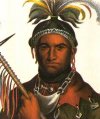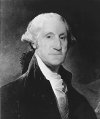|
|
 |
 |
|
Reading Guide |
| 5. |
Seneca Chief Cornplanter, Speech before President Washington, 1790
George Washington, Response to Seneca Indians, 1790
|
|
  |
Native American chiefs had to be clever diplomats. In the Revolution they had to choose sides between two white opponents. After the Revolution, regardless of which side they chose, they had to come to terms with the victorious Americans. Cornplanter, a Seneca chief, made the wrong choice in the war by allying his tribe with the British. In 1779 George Washington sent four thousand troops to attack the Seneca in upstate New York. The devastation they wrought led Cornplanter to sign a treaty that ceded land to the United States. This act not only disgraced him among his people but, as his speech indicates, put his life in jeopardy. After the Revolution he befriended the Americans. His speech calls upon that friendship, history, and simple justice to persuade Washington to enforce the Treaty of Fort Stanwix (1784) that guaranteed the Senecas possession of their land. In his response Washington assures him that he has nothing to worry about. 4 pages.
Discussion questions
| · |
What two perceptions of Washington does Cornplanter offer in this speech?
|
| · |
What is the effect of this contrast? |
| · |
How would you compare this speech to Chief Logan's lament? |
| · |
What does Cornplanter's speech and Washington's response suggest about cross-cultural communication during this period? |
| · |
What is Cornplanter's rhetorical strategy? |
| · |
How would you characterize Washington's response?
|
» Link |
 |
 |
Topic Framing Questions
| • |
What implications did westward migration hold for national unity? |
| • |
How did the citizens of the early republic think about Native Americans and their place in the developing nation? |
| • |
How did Native Americans respond to the westward press of the United States? |
| • |
How did the United States respond to the presence of Native Americans on the western frontier?
|
|
|
 |
 |
|
 |
